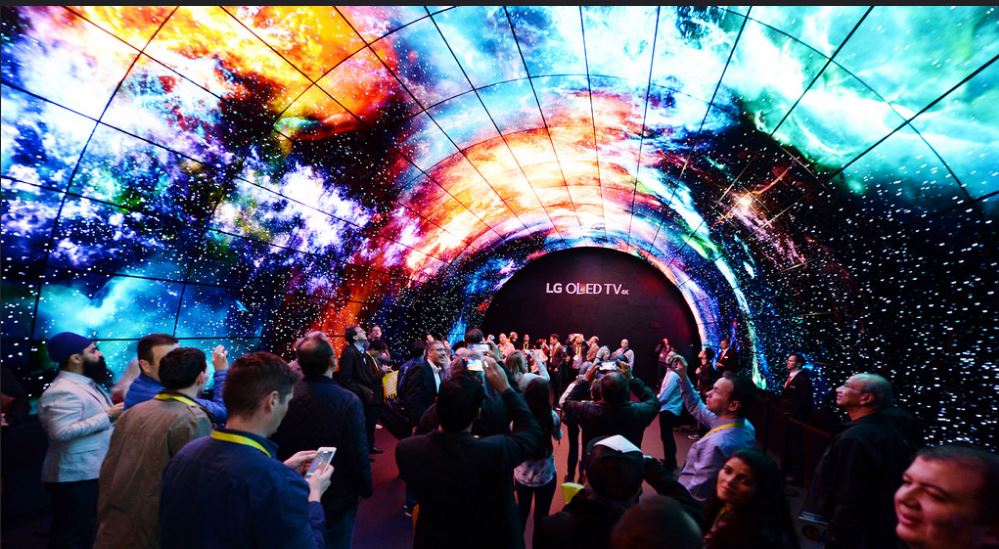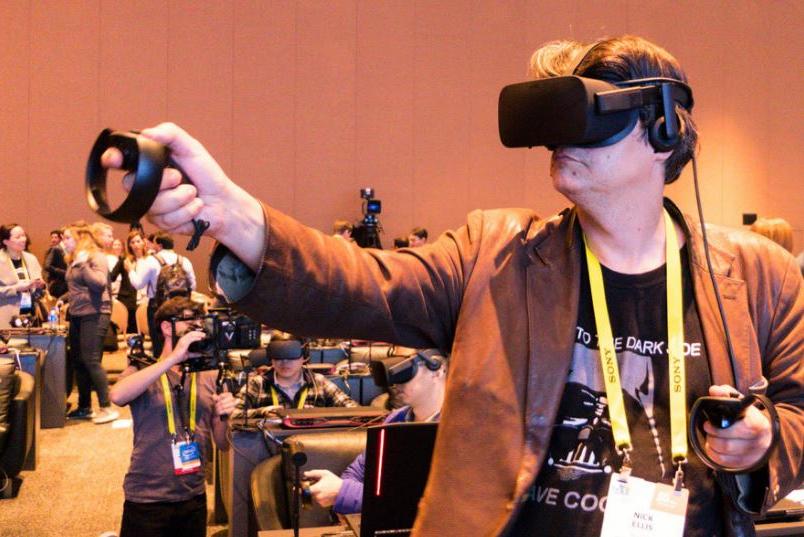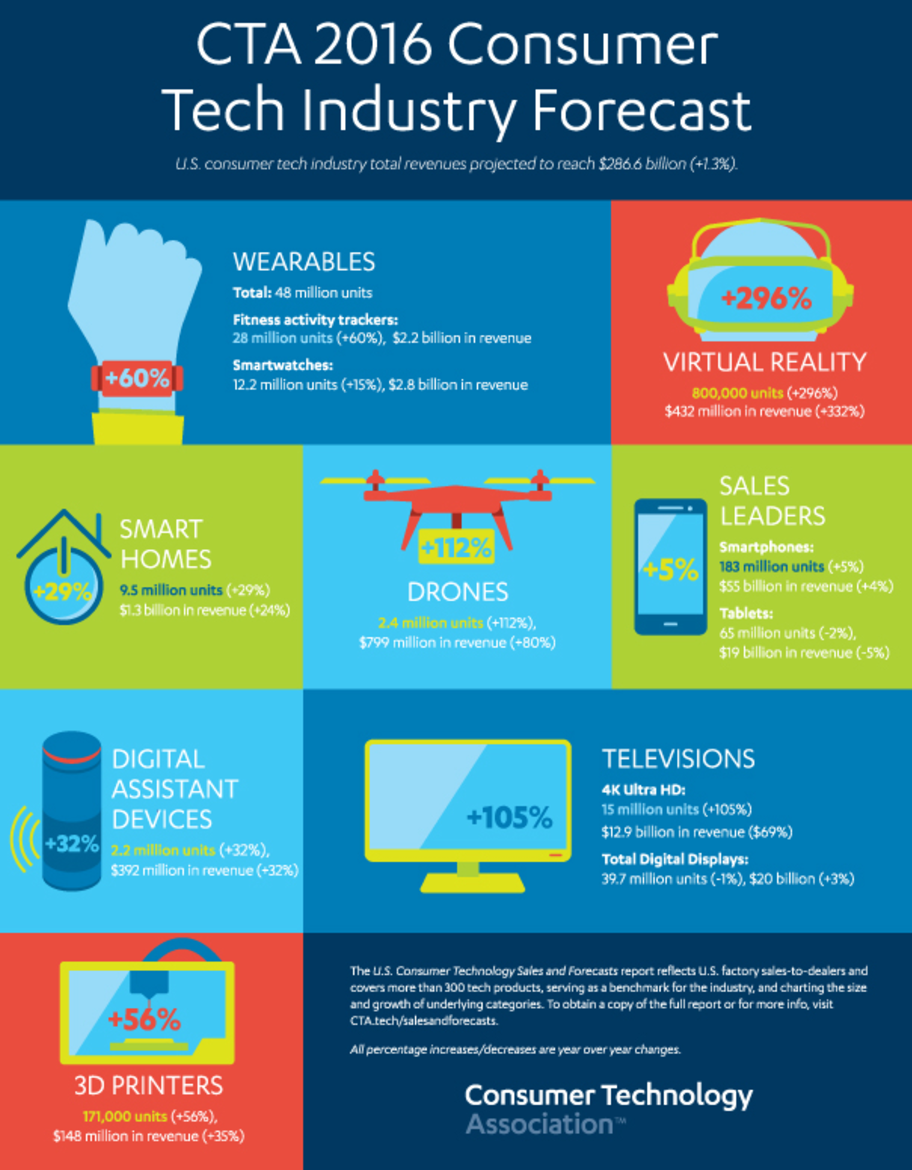Record Year Ahead for Consumer Tech Industry

At CES 2017, people crowd the LG OLED TV display with its curved screen, voted Best of CES 2017. Revolutionary self-lighting pixels, each controlled to achieve perfect black and infinite contrast, support an expanded color palette virtually identical to today’s digital cinemas, Las Vegas, Nevada, January 6, 2017 (Photo by LG) Creative Commons license via Flickr.
LAS VEGAS, Nevada, January 10, 2017 (Maximpact.com News) – White-hot consumer enthusiasm for the Internet of Things and quick adoption of emerging technologies will drive the U.S. consumer tech industry to $292 billion in retail revenues ($228 billion wholesale) in 2017, finds new research from the Consumer Technology Association (CTA)™.
The latest edition of CTA’s semi-annual industry report, “U.S. Consumer Technology Sales and Forecasts,” was released ahead of last week’s CES® 2017, the annual consumer electronics show of shows.
The CTA consensus forecast reflects U.S. factory sales-to-dealers for more than 300 consumer tech products.
The report projects that sales of emerging tech products such as smart home devices, wearables and 4K Ultra HD televisions will help produce 1.5 percent year-over-year growth in industry revenues.
U.S. sales of connected devices are projected to reach 600 million units in 2017 – a record high total and five percent year-over-year increase from 2016.
“Our forecast reinforces our belief that connectivity is going to be one of the driving trends of our time,” said Gary Shapiro, president and CEO, Consumer Technology Association.
“More and more consumers are discovering the remarkable benefits connected products deliver, providing anytime/anywhere access to information, entertainment and each other,” said Shapiro. “Consumers recognize that connected innovations are changing our lives for the better – offering us more control and personalization while helping us lead safer, healthier and happier lives.“
As the nation’s largest tech trade association, CTA’s semi-annual report serves as a benchmark for the consumer technology industry.
The report charts the size and growth of product categories. Among the categories tracked by Consumer Technology Association forecasts:
Smart Home: This is evolving as consumers’ most popular means of IoT engagement, says CTA. The report predicts that the smart home category, including: smart thermostats, smart smoke and carbon monoxide detectors, IP/Wi-Fi cameras, smart locks and doorbells, smart home systems, and smart switches, dimmers and outlets – to reach sales of 29 million units in 2017, a 63 percent increase over 2016. At that rate the category will earn $3.5 billion, a 57 percent increase over 2016.
Digital Assistant Devices: These products present an opportunity to understand how home tech products will integrate artificial intelligence over time. 2017 unit sales projections for voice-controlled, stand-alone digital assistant devices with a cloud-based operating system – including Amaz, 36 percent increase, according to the CTA report.
4K Ultra High-Definition (4K UHD): 4K UHD TVs are one of the industry’s fastest growing segments, driven in part by next-generation technologies such as high dynamic range and wide color gamut.
Growth of the 4K UHD market significantly outpaces the transition to high-definition television, with just three years since introduction; cumulative sales of 4K UHD displays are forecast to hit 18.6 million units, while sales of HDTVs reached 4.2 million units in their first three years on the market.
CTA projects shipments of 4K UHD displays to reach 15.6 million units in 2017, a 51 percent increase over last year, and earn $14.6 billion in revenue, a 38 percent increase.

Intel demonstrates Virtual Reality technology and applications at its CES 2017 press conference, Las Vegas, Nevada, January 5, 2017 (Photo by Vernon Chan) Creative Commons license via Flickr.
Virtual Reality (VR) and Augmented Reality (AR): Among the tech sector’s overwhelming leaders in year-over-year growth in 2017, VR headset unit sales are projected to reach 2.5 million units, a 79 percent increase, and $660 million in revenues, a 43 percent increase.
CTA explains that its AR/VR Working Group has just finalized a set of industry definitions to better explain the spectrum of experiences in this category.
Drones: Total drone sales are expected to reach new heights in 2017, topping 3.4 million units, a 40 percent increase over last year, and $1 billion in revenue for the first time, a 46 percent increase.
CTA’s forecast also delineates U.S. drone sales for units below and above 250 grams, the Federal Aviation Administration’s division for mandatory drone registration: Drones below 250 grams are expected to reach 2 million units, and drones above 250 grams will sell 1.3 million units.
Wearables: Again driven by the popularity of fitness activity trackers, the total wearables market in 2017, including other health and fitness devices, hearables and smartwatches, is expected to reach 48 million unit sales, a 14 percent increase, and earn $5.5 billion in revenue, a three percent increase.
The CTA’s chief economist Shawn DuBravac, Ph.D. says, “2016 was an important year of transition – with potentially game changing products including VR headsets and digital assistant devices gaining steam within mass consumer markets. I expect 2017 to be a year where many of these emerging tech categories find their footing and really take off.“
“We’ve had more progress in voice-activated digital assistants in the last 30 months than in the first 30 years,” said Dubravac.
“Word recognition accuracy has improved from nearly zero percent in the 1990s to 75 percent in 2013 to about 95 percent today – enabling these devices to enjoy immense consumer adoption,” he said. “While still in a period of massive experimentation, we’re increasingly moving away from what is technologically possible and focusing on what is technologically meaningful.“
The automotive sector is another hotbed of innovation. Factory-installed technologies, from entertainment systems to driver-assist features, make up an estimated 50 percent of the collective value in new vehicles, up from about 25 percent just 10 years ago.
CTA estimates factory-installed automotive technologies will contribute nearly $17 billion to industry sales in 2017.
The five largest revenue drivers are maturing technologies that will contribute almost half of total industry revenue in 2017:
Smartphones: Unit volume will grow three percent to reach 185 million smartphones sold in 2017, with revenues expected to reach $55.6 billion, a two percent increase. Unit volume will taper off by 2020, as hardware better meets the average user’s computing demands and replacement cycles lengthen.
Televisions: While LCD television unit shipments enjoyed their best year yet in 2016, 2017 will initiate a period of slight declines with unit volume at 39 million units, a two percent decrease, and $17.8 billion in revenue, a two percent decrease, CTA projects. Future category growth will be driven by 4K UHD upgrades.
Tablets: While tablets remain one of the best performing categories in terms of total volume, after momentous adoption of tablets over the past five years, near-term adoption has leveled off and replacement cycles have slowed. Tablet sales will decline in 2017, as CTA expects sales of 59 million units, a five percent decrease, and revenues of $16 billion, an eight percent decrease.
Laptops: In 2017, the laptop market will sell 27 million units, holding steady with last year, and earn $15.6 billion in revenue, a three percent decrease. Future growth in the laptop market will come from convertible models, CTA predicts.
Desktops: The desktop market will continue to see structural declines, with projected unit sales of 6.7 million, a seven percent decrease, and revenue of $3.9 billion, an eight percent decrease.
Despite revenue declines across some of the largest categories, CTA reports that unit shipment increases demonstrate continued resilience in these categories.
“Continued revenue growth in the U.S. consumer technology sector is critical to overall U.S. economic growth,” commented Shapiro. “Our sector supports more than 15 million jobs across the nation, directly, indirectly and induced, and accounts for more than 10 percent of total U.S. GDP, per a recent CTA economic study.“
Create clean tech projects through Maximpact’s Advisory and discover project services for all types of business and organizations. Find the right expertise for your projects through Maximpact consulting network. Contact us at info(@)maximpact.com and tell us what you need.

